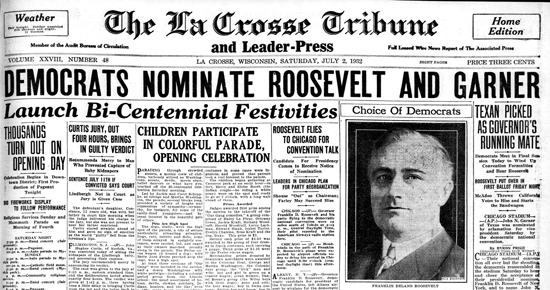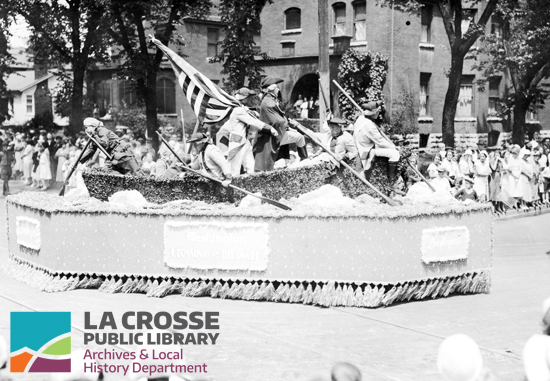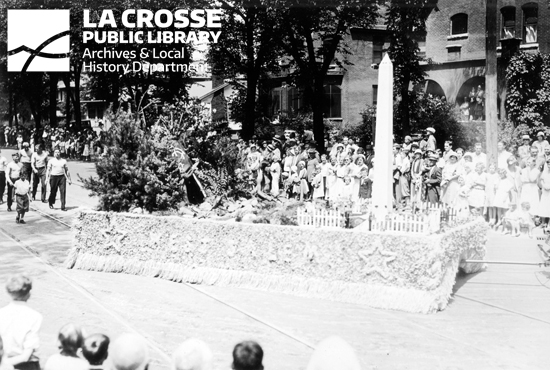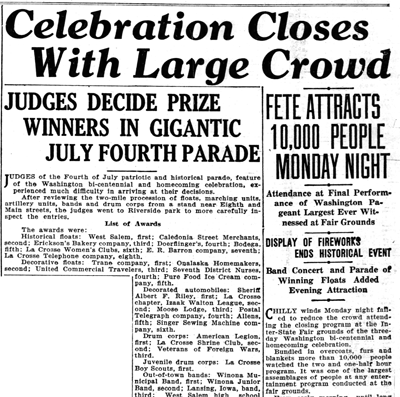
1932 George Washington Bicentennial Celebration
(written by Scott Brouwer, Archives staff)
In the worst depths of the Great Depression in 1932, the 200th anniversary of George Washington’s birth was a reason for the United States and its citizens to celebrate. The George Washington Bicentennial Commission had been established by President Calvin Coolidge and Congress way back in 1924 to oversee the celebrations taking place around the country. Many cities chose to schedule their celebrations around the 4th of July.

La Crosse Tribune 4 July 1932
La Crosse’s Washington Bicentennial Celebration was held over 3 days – Saturday, July 2 through Monday, July 4. Many events were planned and thousands of visitors from surrounding communities in the tri-state area were expected.

The local arrangements committee for the Washington Bicentennial Celebration asked the citizens of La Crosse to enjoy the celebration while also welcoming the thousands of expected visitors to the city - La Crosse Tribune 1 July 1932
Saturday’s events began with a morning “Kiddie Parade” in which dozens of entries made their way around downtown. This was followed all day by staggered 15-minute concerts by city bands on street corners in both the downtown and north side business districts. Saturday was also the first night of the scheduled 3 consecutive nights of celebration at the Interstate Fair Grounds (the area now occupied by UW-La Crosse’s Veterans Memorial Stadium) that included a large band concert at 7:30pm, a grand pageant at 8:45pm, and fireworks at 10:30pm.
The pageant portrayed important events in the life of George Washington and included a cast of over 600 La Crosse adults and school children. Rehearsals were held for several weeks under the direction of “pageant experts” from the John P. Rogers Producing Company out of Ohio. Seated and standing sightlines for 5,000 attendees were provided for each of the pageant’s 4 performances over the course of the weekend. A promotional description of the event:
[The Rogers Company] has rounded into finished excellence a cast of more than 600 who will portray in spirited action and song events in the life of George Washington, ranging from his early life on the Rappahannock to his inauguration as president of the United States. Elaborate costume settings and lighting effects have been provided by the Rogers Company and with the ideal facilities that prevail at the fair ground for staging an event of this kind, the pageant should be one of the most beautiful, and thoroughly entertaining spectacles ever seen in this community.

Saturday evening’s La Crosse Tribune heralded the success of the first events and confirmed the thousands of expected visitors. The headline though was that of news from the Democratic National Convention announcing Franklin D. Roosevelt as the party’s presidential nominee for the 1932 election. Roosevelt would not only win the election later that year, he would go on to serve 3+ terms and become the first and only president to circumvent George Washington’s precedent of serving just two terms before the 22nd amendment to the US Constitution was ratified in 1951 making the two-term limit the law of the land.

La Crosse Tribune 2 July 1932
Sunday celebration plans centered around religious services to be held at Myrick Park. Planners anticipated more than 10,000 La Crosse citizens and visitors would attend the Catholic field mass in the morning and the Associated Protestant Churches service in the afternoon. However, overcast skies and consistently drizzly rain caused these celebrations to relocate to St. Joseph’s Cathedral and the auditorium at La Crosse State Teacher’s College (now UW-La Crosse), respectively, and were consequently much smaller affairs. The evening festivities of band concert, pageant, and fireworks at the fairgrounds were also cancelled.
Monday, July 4, was obviously planned to be the high point of the celebration, and it did not disappoint. The weather was perfect for “La Crosse’s greatest patriotic and historical parade” in the morning, which featured more than 100 marching clubs, bands, drum corps, floats and comic groups. Historical floats were emphasized with local civic clubs, fraternal organizations, businesses, and individuals creating meticulous re-creations months in advance. The 2-mile long parade, headed by the artillery unit of the Wisconsin National Guard, began and ended at Riverside Park; it first headed east on Main Street, turned north on West Avenue, then headed back west on State Street.




The afternoon included a kittenball game at Copeland park, a gathering of “old-timers and homecomers” at the YWCA, and a 5pm “automobile tour of the city and surrounding coulee region”. The band concert and grand pageant at the Interstate Fair Grounds were presented twice that day, at 2pm and 7:30pm. The grand finale evening performance was enjoyed by more than 10,000 people, noted at the time as “one of the largest assemblages of people at any entertainment program conducted at the fairgrounds”. The massive pyrotechnics show at the end of the evening was made even bigger by including the fireworks that were not shot off due to rain the night before.

La Crosse Tribune 5 July 1932
